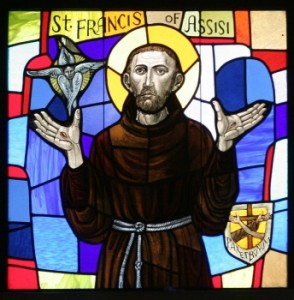
Pope Francis chose to name himself after St. Francis of Assisi. Why is this saint so popular after nearly 800 years? This reflection on St. Francis’ life might provide some clues. Why do you think St. Francis speaks so clearly to us today?
Most people have heard of St. Francis of Assisi, but how much do we actually know about him? We see his statues in gardens and have a vague idea that he was poor and liked animals, but if this is all he was, then why is he still so popular nearly 800 years after his death?
St. Francis of Assisi was born in 1181 and, at his baptism, was given the name Giovanni. His father, a wealthy silk merchant, loved all things French and gave his son the nickname Francesco. Francis had a fairly typical upbringing for a boy of his time and, as a young man, he was known to enjoy the music of the troubadours, bright clothing, rich friends, and good times. As a young adult, he became a soldier, but was captured at his first battle and spent a year as a captive.
Following his recovery from a serious illness, Francis became a new man. He began nursing lepers and begging, both in Rome and in Assisi. Finally, in a vision in the country chapel of San Damiano just outside of Assisi, Francis heard Jesus saying to him: “Francis, Francis, go and repair My house which, as you can see, is falling into ruins.” When Francis sold some of his father’s cloth to pay for the repairs to this church, his father was irate. Francis renounced his father and his wealth, stripped naked in public, and left to live as a beggar.
Francis then heard a sermon on Matthew 10:9 in which Jesus tells his followers that they should go forth and proclaim that the Kingdom of God was upon them, that they should take nothing with them – no money, no walking stick, no shoes for the road. This sermon inspired Francis to devote himself to a life of poverty. So, dressed in ragged clothes and barefoot, he began to preach on the streets to whoever would listen. Within a year, Francis had eleven followers and this group lived together as “lesser brothers” (or Friars Minor). The brothers lived a simple life and spent much of their time wandering through the countryside, always cheerful and full of songs, yet making a deep impression upon those who heard their preaching.
Francis was uninterested in becoming a priest, but it was highly unusual for ordinary people to preach. So, Francis sought official approval for his followers. He composed a “Primitive Rule,” largely made up of passages from the Bible, which stressed the call “to follow the teachings of our Lord Jesus Christ and to walk in his footsteps.” Francis led first eleven followers to Rome to seek permission from the pope for his new religious order which was somewhat reluctantly given (due to the new and unusual nature of Francis’ order).
Having received official approval, Francis’ order grew quickly and many men and women were attracted to his new life. Clare, the teenage daughter of a noble family in Assisi, was deeply touched by Francis’ message and she felt her calling. When she was eighteen, she snuck out of her family’s palace and was received by Francis into religious life. Very soon, many women of Assisi, including Clare’s mother and sister, joined her.
Francis was always focused on preaching the Gospel and he and his brothers began travelling throughout Europe to do so. Francis himself made several attempts to go to the Holy Land to preach and, according to legend, eventually was able to preach the gospel to the Sultan of Egypt. Even with all this travelling or perhaps because of it, Francis realized that his order’s organization had not kept up with its growth. To address this problem, Francis prepared a new and more detailed rule, the “First Rule,” which again asserted devotion to poverty and the apostolic life while also introducing greater institutional structure. Due to pressure from some inside is order, Francis revised this rule, creating a “Second Rule,” which was endorsed by the pope.
Francis increasingly withdrew from the management of his order. It was during this time that, according to legend, he set up the first crèche, creating a living nativity scene so that worshipers could contemplate the birth of Jesus in a direct way, making use of the senses. It was during this time that Francis also received the stigmata, making him the first recorded person to bear the wounds of Christ. He died during the evening hours of October 3, 1226, after spending the last days of his life dictating his spiritual testament.
Francis was declared a saint on July 16, 1228 and, in 1230, his body was moved to the Lower Basilica in Assisi. His tomb was kept hidden to protect it from Muslim invaders and its location was eventually forgotten until its rediscovery in 1818.
For Francis, all Christians are called to imitate the life of Jesus; he believed that his followers were also called to imitate the poverty of Jesus. Poverty was so central to his understanding of Jesus that, in his last written work, he said that absolute personal and corporate poverty was essential to the lifestyle of the members of his order. Francis is also famous for preaching that centered around several themes: Creation is good and beautiful, although in need of redemption. All creatures are called to praise God. All people are called to care for and be responsible stewards of creation. And God calls all people to a deep sense of commitment to all of humanity.

